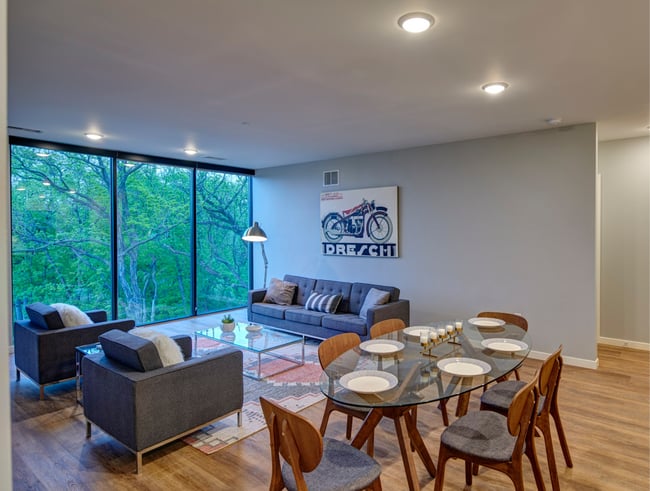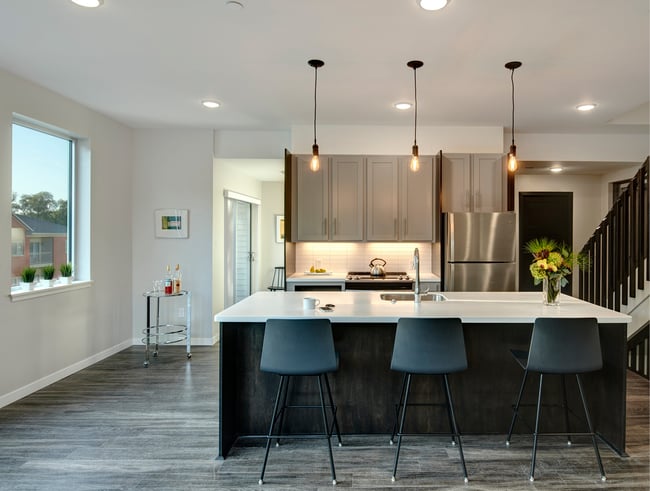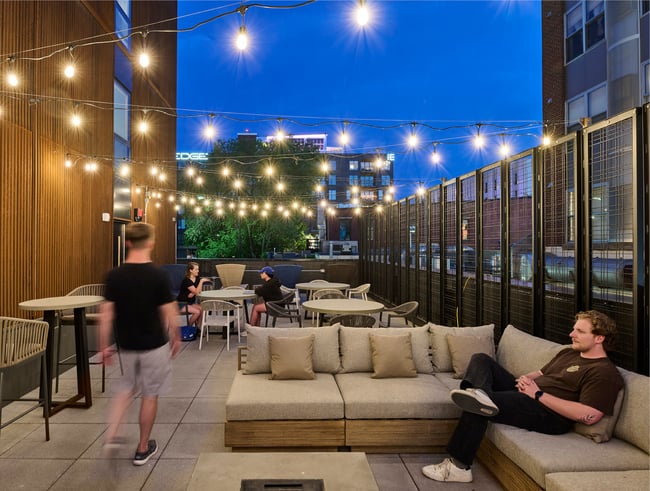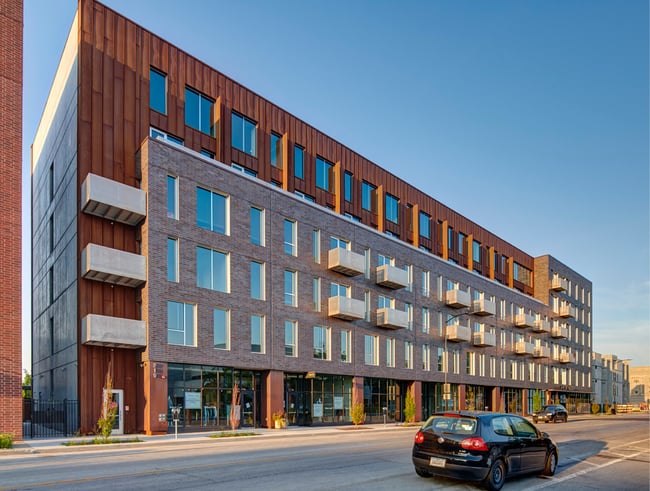Best Places to Invest When Designing a Multifamily Development

Every building project has a limited budget—and multifamily developments are no exception. To achieve a return on investment, developers must spend construction dollars wisely.
Over the years, we’ve worked with many multifamily and mixed-use developers in Iowa City and Des Moines. We always recommend our clients invest in project areas likely to attract tenants and impact their experience. Similarly, we recommend investing in materials and systems that lower maintenance and operating costs.
To help you prepare for your project, this article will discuss a few investments to make when planning a multifamily development.
Investments to Make for Multifamily Developments
1. Connection to the Outdoors
Individual units are the most important space for attracting tenants. Buyers and renters are looking for a home, a space that feels welcoming and comforting. Units should be well-lit and appear spacious, with connections to the outdoors.
Large windows are one of the best investments within units. Often, we recommend floor-to-ceiling glazing. This practice not only increases daylighting and views, but it creates the illusion of taller ceilings. Additionally, unit layouts should allow outdoor views from the entry.

Floor-to-ceiling glazing can increase daylighting and views.
Balconies can also be an effective way to create a connection to the outdoors. Many buyers and renters desire a private outdoor space, and balconies can increase a unit’s marketability.
Juliet balconies are another option, especially when faced with limited space. While these balconies may not provide outdoor seating, they allow tenants to open doors and let in light and air.
In addition to attracting tenants, balconies can improve a building’s curb appeal. They may carve into a façade and break down massing, making a building less imposing and more pedestrian friendly.
2. Kitchens and Bathrooms
In addition to windows and balconies, we recommend investing in kitchen and bathroom finishes.
The kitchen is the most prominent design feature within an apartment unit, and the level of detail can make or break the unit’s appeal. Spending a little more on countertops, cabinetry, and lighting can create a cohesive look and feel.

Investing in countertops and cabinets can increase a unit's appeal.
The same rule applies to bathrooms. These spaces tend to be small and intimate, so it helps to emphasize quality material selections.
Bathroom materials and plumbing fixtures account for only a small portion of a project’s overall budget. Investing in higher quality, durable finishes can go a long way in improving occupant comfort without adding much to the project’s cost.
3. Amenities
In recent years, amenities have become a staple of multifamily developments, especially in larger markets. Younger tenants are looking for communities with dedicated spaces for socializing. Similarly, older tenants downsizing to condominiums desire the opportunity to address multiple needs within one building.
Investing in amenities can help your building stand out in a competitive market and attract your target renter or buyer. Spaces like fitness rooms, coffee bars, rooftop terraces, and courtyards give tenants places to gather outside their units.

Social spaces like outdoor terraces can attract your target market.
Depending on your market, you may consider pools, movie rooms, weather-protected bike storage, and co-working spaces. In general, smaller units are becoming more acceptable if the building provides other amenities, and you may be able to charge a higher cost per square foot with communal spaces.
Another approach is to find a commercial anchor tenant who synergizes with the residential development. Restaurants, bars, coffee shops, and grocery stores can be major selling points for buyers and renters.
Some developers invest in commercial spaces first. A commercial establishment can attract people to an area, setting a residential development up for success.
4. Exterior Finishes
To reduce the long-term costs of ownership, we always recommend investing in durable, low-maintenance exterior finishes. In general, you should avoid systems that rely on paints and sealants, which can degrade over time.
Masonry and rain-screen systems with natural materials are always good options. When using architectural metal panels, use systems without closed joints or sealants, especially on high-rise construction.

High-quality finishes minimize maintenance while boosting curb appeal.
In addition to durable exterior finishes, we recommend investing in the building’s entry. This area is where most visitors first engage with the building. Using high-quality materials with refined detailing can create a statement and give the building an identity.
5. Security
Investing in security features can go a long way toward attracting and retaining tenants. Features like keycards and secured entries provide peace of mind and help ensure a safe community.
Similarly, secure package rooms are becoming more common with the rise of online shopping. Developers might consider investing in features like smart lockers to protect tenants’ purchases.
Along with these more active features, we recommend investing in passive security measures. Exterior lighting can make tenants feel safe at night, deter unwanted visitors, and boost the building’s curb appeal.
Likewise, common areas like circulation spaces should provide daylight. Natural lighting can make these often-overlooked spaces more welcoming, creating a sense of psychological security.
6. Energy-Efficient Features
Lastly, it’s always a good idea to invest in energy-efficient design measures. Features like high-performance mechanical systems can translate to lower utility costs, helping attract and retain tenants. Developers may also consider investing in on-site renewable energy to power common areas.
While energy-efficient systems can increase initial costs, they provide a return on investment through reduced ownership costs. You may also receive rebates from utility providers, depending on your location.
In Iowa, developers in MidAmerican Energy and Alliant Energy’s service areas can take advantage of the Iowa Commercial New Construction Program. The program provides complementary design assistance and energy modeling, along with rebates for improved performance.
Learn More About Multifamily and Mixed-Use Development
Investing construction dollars wisely is crucial to the success of any building project. On a multifamily development, we recommend focusing on areas most likely to impact tenants’ experience.
Connections to the outdoors and high-quality kitchen and bathroom finishes can elevate individual units, attracting buyers and renters. Additionally, communal spaces, security features, and energy-efficient design can help developers stand out in competitive markets.
Multifamily developments are one of the fastest-growing sectors in the building industry. When successful, they can help revitalize neighborhoods and fill gaps in the housing market.
Achieving success in the multifamily market requires careful consideration of your target renter or buyer and their needs. For more insights into this building type, read our tips for planning a mixed-use or multifamily development.